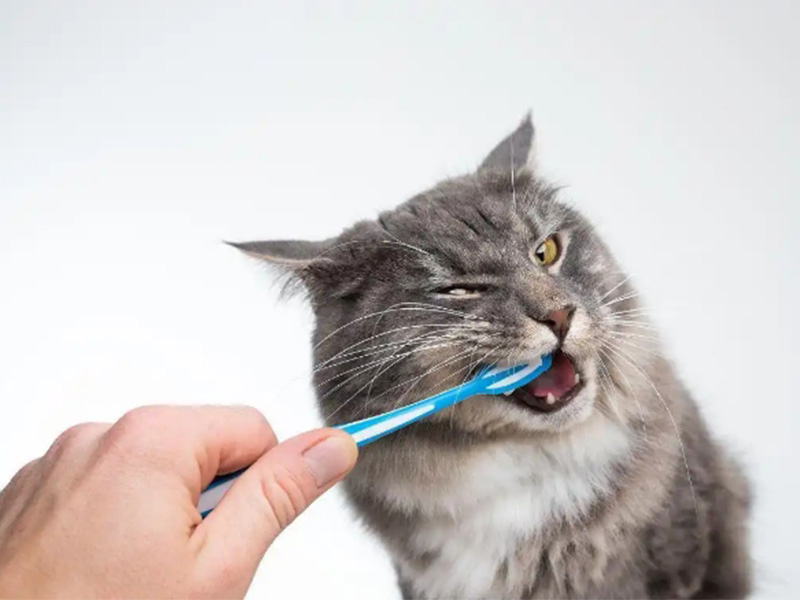
Brushing your cat’s enamel is a complete game-changer for their health—but let’s be real, it can sense problematic at first. The correct news? With a little staying power and the proper steps, it’ll flip into a quick, handy routine.
Not solely does it reduce down on germs in their mouth, however it additionally stops painful dental troubles earlier than they start. Below, we’ll damage down why it matters, what you need, and how to get your cat comfortable with the process.
Why Brushing Your Cat’s Teeth Is Non-Negotiable
Cats get mouth issues way extra than you would possibly think—most of the time, it’s from leftover meals and plaque constructing up. Regular brushing fixes that by:
Preventing mouth diseases: It wipes away meals bits, plaque, and tartar, which lowers the chance of gum infection and teeth decay.
Freshening their breath: A smooth mouth potential no extra pungent cat breath (win for each of you!).
Boosting general health: Bad dental care can lead to infections that unfold to different components of their body—so taking care of their enamel continues their complete device happy.
What You’ll Need to Get Started
Before you dive in, clutch these elements and set up a calm spot (think a quiet room the place your cat feels safe):
A cat-specific toothbrush: Look for one with a tiny head and tender bristles—this makes it handy to attain all their tooth besides bugging them.
Pet-safe toothpaste: Never use human toothpaste—it’s poisonous for cats! Stick to formulation made simply for them (many have flavors like hen or fish to make it extra appealing).
Extras for first-timers: Cotton balls and gauze can assist with preliminary cleanings and drying their mouth.
Treats: Have their preferred snacks reachable (think tiny portions of hen or fish)—you’ll provide these after brushing to make it a nice experience.
Step-by-Step: How to Brush Your Cat’s Teeth
The key right here is to take it slow—don’t rush your cat into it. Here’s how to do it:
Let them get used to the equipment first: Let your cat sniff and lick the toothbrush. If they’re hesitant, dip the brush in a little tuna juice or poultry broth—this helps them accomplice it with some thing tasty. You can additionally put a tiny dot of pet toothpaste on your finger and let them lick it off to get used to the flavor.
Start with a mild wipe (for newbies): Wrap a piece of gauze round your finger, dip it in heat saltwater, and softly rub their teeth. This wipes away free meals and plaque besides overwhelming them.
Add the toothbrush: Squeeze a tiny quantity of pet toothpaste onto the brush (about the measurement of a grain of rice). Gently open your cat’s mouth—you can use one hand to carry their top lip slightly—and brush in slow, round motions, beginning with simply 2-3 teeth.
Build up over time: If your cat stays calm, add a few extra tooth every day. Focus on the outer surfaces of their tooth (that’s the place plaque builds up most) and maintain the brush moves gentle—no scrubbing!
Wipe up and reward: After brushing, use a cotton ball to wipe away any leftover toothpaste. Then provide them a deal with and a lot of pets—positive reinforcement is how they’ll analyze to tolerate (and perhaps even like!) brushing.
Pro Tips to Keep It Smooth
Be patient: If your cat squirms or tries to stroll away, take a break. Forcing it will solely make them hate the process. Try once more later when they’re at ease (like after a nap).
Don’t rush: It’s higher to brush 2-3 tooth nicely than to hurry thru all of them and stress your cat out. Over a week or two, you’ll work up to brushing their complete mouth.
Keep equipment clean: After every use, rinse the toothbrush with heat water and let it air dry. This stops germs from growing.
Watch for pain: If your cat hisses, pulls away, or acts sore at some stage in brushing, quit and name your vet—they would possibly have a hidden dental issue.
Have backups if needed: If your cat sincerely won’t let you use a toothbrush, strive cat-safe dental wipes, mouthwash, or dental powders instead. Something is higher than nothing!
